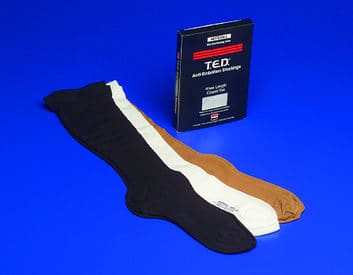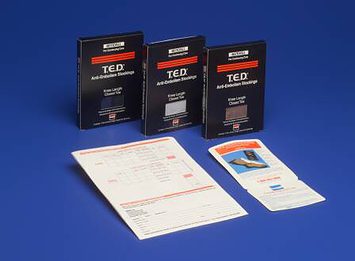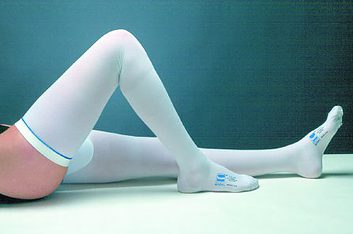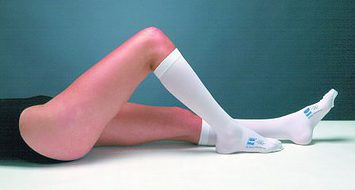Compression stockings or anti-embolism stockings are often recommended to treat poor blood flow in the legs, such as varicose veins. Varicose veins can be painful for some and can be treated with surgery, but compression socks may be an at-home option to address the issue effectively.
What are varicose veins?
Varicose veins are large swollen veins that typically appear dark purple or blue, lumpy or bumpy, and on the legs. Healthy veins allow the blood to flow smoothly down the legs and back up to the heart. Small valves that become weak or damaged prevent the blood from flowing freely back up to the heart, and it ends up pooling in the veins and causing them to enlarge.
Varicose veins are a product of venous insufficiency, a medical condition where there is improper functioning of the valves in the veins of the legs. According to the Society for Vascular Surgery, approximately 40% of the US population may be affected by venous insufficiency.
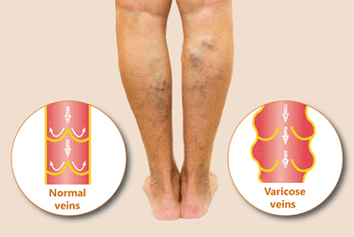
Causes of varicose veins
There are several reasons a person can develop varicose veins, although some get them for no specific reason. Some of the common causes for a person to develop varicose veins are:
- Age – Veins lose elasticity as we get older.
- Genetics – If immediate family members are affected, a person’s risk increases.
- Gender – Women are more likely to be affected than men due to hormones.
- Pregnancy – Blood quantity increases to support a developing baby putting extra strain on veins.
- Occupation – A job that requires standing for long periods can prevent blood from flowing as easily.
- Obesity – Being overweight puts pressure on the veins, making them work harder to send blood back to the heart.
What are compression stockings?
Compression stockings are hosiery made of elastic that deliver graduated amounts of pressure from the ankle up the leg, promoting the blood flow back up to the heart. They can help reduce the symptoms of painful varicose veins, promote better circulation, and slow the progression of vein disease. These stockings are tighter at the ankle than the calf and even less up the thigh for full-length stockings.
These stockings deliver varying levels of compression, and some are different. Medical compression socks and stockings are needed to relieve varicose vein symptoms. These stockings and socks have strict medical and technical specifications that they are manufactured under. The compression level is measured in millimeters of Mercury (mmHg), the same way blood pressure is measured.
The three primary levels of medical compression include:
- Mild compression – Supports healthy blood flow back to the heart and allows the legs to feel lighter.
- Moderate compression – Recommended for those with varicose vein symptoms.
- Firm compression – For more vein diseases more severe such as leg ulcers, lymphatic edema, and deep vein thrombosis (DVT).
How compression stockings can help varicose veins
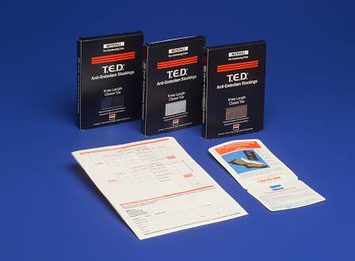 So how do compression stockings help with vericose veins?
So how do compression stockings help with vericose veins?
Compression socks and stockings can help promote better circulation and are available in various sizes, lengths, colors, and compression levels to suit different needs. They may temporarily reduce the pain, swelling, and skin damage of varicose veins but will not correct the underlying vein problem. Compression socks and stockings will help slow the deterioration of the vein and may help prevent new varicose veins from forming. However, the only way to make varicose veins go away is to have them surgically removed.
T.E.D. is a popular brand of compression stockings that offers knee-high and thigh-high stockings in closed-toe and open-toe options. T.E.D. anti-embolism stockings help promote blood flow velocity in the legs and are commonly used after surgery to reduce the risk of blood clots (DVT) forming.
How to measure yourself for compression stockings
Selecting the right size and compression level of anti-embolism stockings is a large part of being comfortable. To ensure a proper fit, you will need to take some measurements. This handy guide makes taking measurements easier.
Are there any risks of compression stockings?
There are usually no side effects from using anti-embolism stockings, but since they are tight, some may find them challenging to put on. And people with damaged nerves in the legs might not feel how tight the stockings are. The few risks of anti-embolism stockings include the following:
- Discomfort – Improper sizing is more likely to cause problems.
- Skin irritation – Some of the materials to manufacture stockings can irritate the skin.
- Dents in the skin – Temporary dents can form where the elastic bands hold the stockings in place.
Compression socks and stockings should not be worn for too long. It is essential to treat them as you would any other clothing item by removing them daily and laundering them gently. Although compression socks may not cure varicose veins, they can help reduce pain and swelling and prevent the worsening of vein disease.


